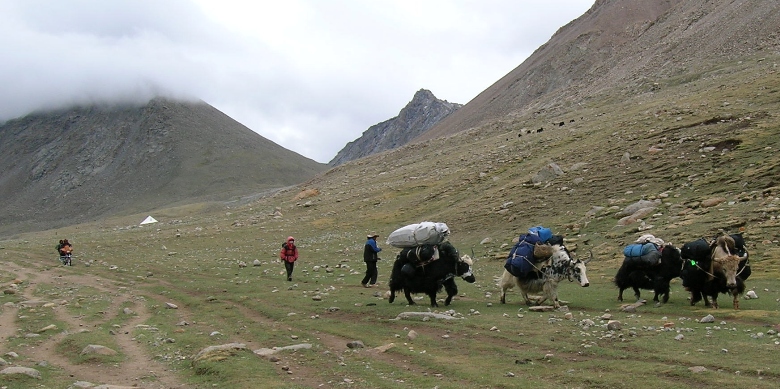|
Prelude
Day 1: Arrival in Lhasa
Day 2: Sera Monastery
Day 3: Bumpari Mountain
Day 4: Urban Kora
Day 5: Drepung Monastery
Day 6: Potala Palace Kora
Day 7: Gyaphelri Mountain
Day 8: Preparations for Kailas
Day 9: Gyantse
Day 10: Tashilungpo Monastery
Day 11: Lhatse
Day 12: Saga
Day 13: Pariyang
Day 14: Darchen
Day 15: Dirapuk Monastery
Day 16: The Glacier
Day 17: Dzutrulpuk Monastery
Day 18: Lake Mansarovar
Day 19: Return to Saga
Day 20: Nyalam
Day 21: Return to Lhatse
Day 22: Lhasa 2.0
Coda
|
Day 14: Dirapuk
I get up a little after 3.30 a.m. and leave our room silently without turning on the light.
I have a little trouble even finding my way across Darchen in the complete darkness.
Eventually I work my way across to the area where the kora may (or may not) begin.
I walk vaguely off in what is possibly the right direction,
and I have the piece of good luck I was hoping for.
I see a group of Tibetans, without flashlights, gliding like ghosts ahead of me. I put on a spurt to get into their 'slipstream'
and turn off my flashlight, since I can only pickup their silhouettes when my light is off. I can just keep up with them on the flat, but as soon as they start to climb at all I am in big trouble - no matter how hard I breathe or how hard I push my legs I can't compensate for the heaviness of my pack. I absolutely have to keep up, however, because I have no idea at all where I am.
We climb up to the ridge crest and the Tibetans (and I) do some prostrations to the mountain. In the dark I completely miss two important places on the pilgrimage: a two-legged arch through which pilgrims are supposed to pass to start the kora, and a sky-burial site up to the right that is a propitious site for Chöd practice. Sky-burial is the practice of hacking corpses up into pieces to be eaten by vultures, and is still a common practice in wilder areas of Tibet where wood for cremation is unavailable and the ground is frozen much of the year. Chöd is for me the most powerful of the Tibetan Buddhist practices, in which I mentally invite different classes of beings to feast on my sacrificed body - demons who wish me ill, those whom I have mistreated or to whom I owe karmic debts, those who need my help, and enlightened beings who can use my resources to help others. Chöd is supposed to be done in frightening places, and a sky-burial ground on Kailas would certainly qualify. Practitioners are also supposed to cultivate a wild and unkempt personal appearance and to do things that make no rational sense, and right now I feel like I have both of those down too. I have the liturgy (which I plan to, and will, use at the Dakini Charnel ground): all I'm missing are the ritual drum and the human thighbone trumpet.
Having completely missed the start of the kora and one of its most powerful experiences, I continue up the wide river valley to the West of Kailas. A single light from the slopes of the otherwise-pitch-black mountainside to my left is presumably Choku Gompa, home of some extremely precious thousand-year-old relics of Naropa. Naropa was a renowned Buddhist scholar who left Nalanda University after meeting an old woman who rejoiced when he told her that he had memorized all the Buddhist scriptures, but then cried when he said that he also understood their true meaning.
He studied with an eccentric yogi called Tilopa, despite Tilopa's resume not being nearly as impressive as his (the only two items on it that I remember being pounding sesame seeds into tahini by day and moonlighting as a procurer for a prostitute.) Tilopa put Naropa through many extreme trials, presumably intended to develop his trust and to loosen his attachment to what his mind was telling him. Finally Naropa became a teacher in his own right and was visited by students from Tibet, in particular Marpa, the famous translator of Buddhist texts and teacher of Milarepa, who brought the Buddhist teachings into Tibet.
I can't find my way up to the Gompa in the dark, and am in too much of a hurry to wait till daylight, so I press on. I am dimly aware that in typical American style I may be sacrificing quality of experience for quantity here, but the awareness has not yet sunk in enough to affect my actual behavior.
The first faint glimmerings of pre-dawn light reveal human figures gliding through the darkness. Their gait appears soft and slow, yet I am unable to keep up with any of them. Seen from a distance they remind me of the penitents in Dante's Purgatorio, the second part of the Divine Comedy, purging the stains on their souls made by the Seven Deadly Sins by traversing the seven levels of the sacred mountain. Up close these Tibetan pilgrims (for that of course is who they are) create a completely different impression. They are all very cheerful, and seem to be carrying virtually no baggage, physical or mental. Some are carrying a small daypack or even a purse, some are carrying nothing at all, and their general demeanor seems more fitting for an afternoon picnic in the park than a pilgrimage in one of the most sacred and remote places on earth. The contrast with my own earnestness and hurry, and the forty-pound pack on my pack, couldn't be more extreme.
I am unable to keep up with any of them, even the schoolkids. Finally I fall in behind a stooped old man in his sixties, with a pretty bad limp, who stops every few hundred yards to do multiple sets of prostrations. I fall behind him while he is walking, but am just able to catch him up when he stops to do his prostrations. After half an hour or so he, too, dusts me.
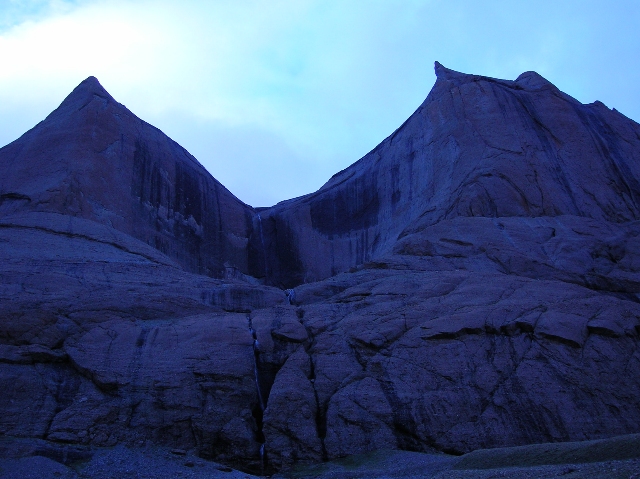 | Mountains of the Western Valley |
The mountains enclosing this river valley slowly reveal themselves. They are gigantic and overwhelming, but completely devoid of beauty in any conventional sense. If Kailas perhaps looks as if it were made by God, these clearly arose out of the interplay of titanic but random natural forces. Maybe God placed them there as a counterexample to anyone tempted to believe in Intelligent Design? [So deep is our tendency to look for order and meaning everywhere that perhaps I need to explain that this is a joke!]
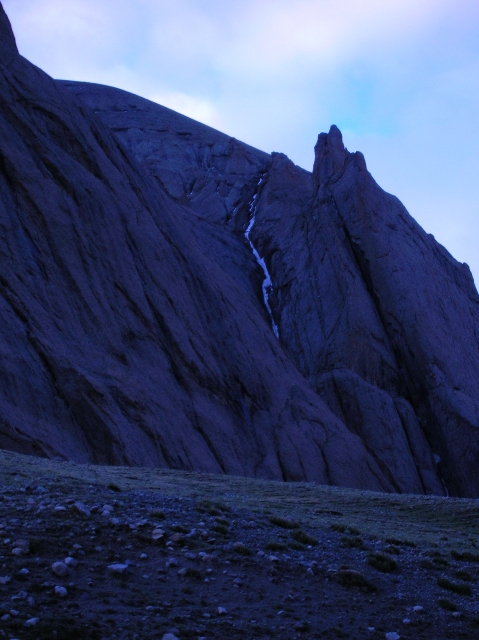
Waterfall of the Western valley |
I pass a thousand-foot-high waterfall that appears to come from the crest of a ridge. No matter how hard I think I can't come up with a scenario where that would be possible - from where could the water possibly be coming?
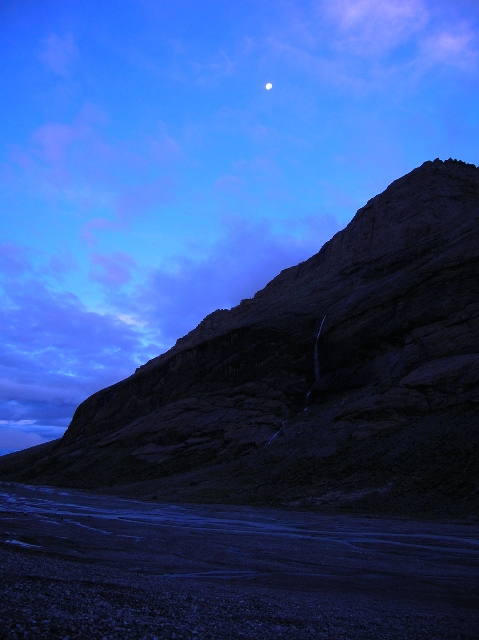 | Moon Seen over the Shoulder of the Western Valley |
I chose the dates for this trip as a function of the phases of the moon, so I would have moonlight if I needed an early start, but so far the moon has been a no-show. Suddenly, she shows herself over the shoulder of the valley.
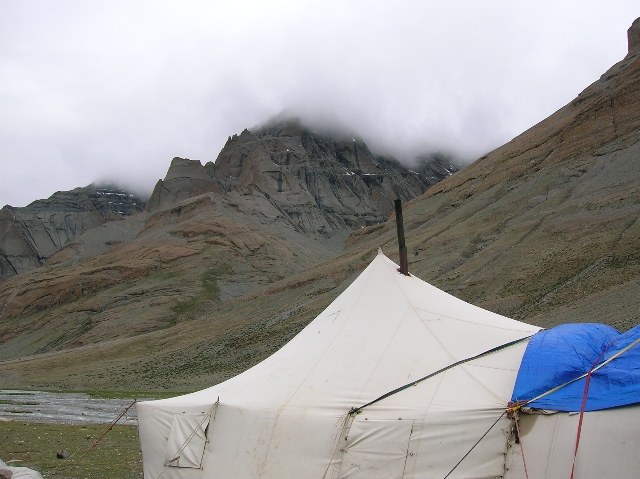 | Tea Tent at North Corner of Western Valley |
At about 8 a.m. I pass the shoulder and come to a tea tent. It looks as if in clear weather this might be the first place with a clear view of Kailas. Right now the mountain is socked in, so I take a break partly because I need one and partly in the hope that the weather will clear. I order some dried noodles: once I add the flavor packet the result is so hot that I can't eat any of it, and so I move on.
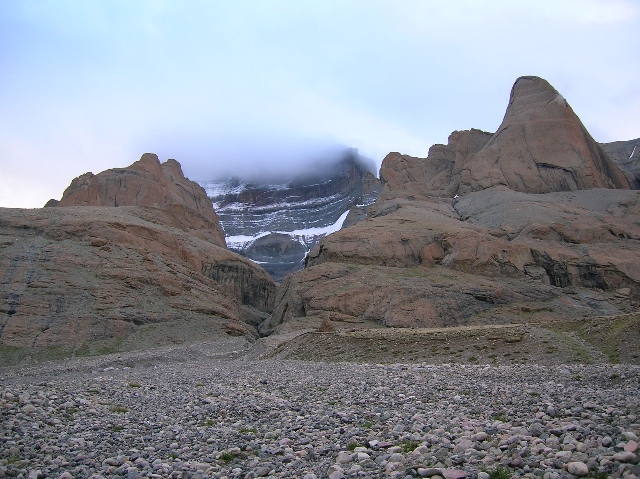 | View from the Tea Tent |
The path turns to the East, following the river upstream to the right.
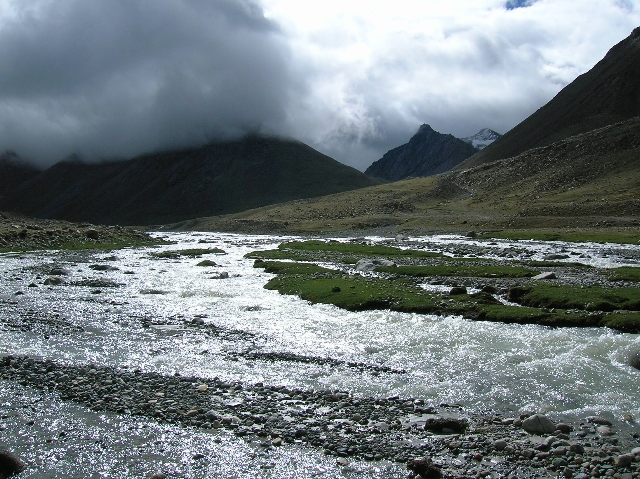 | River on Northwest Corner of Kailas |
Soon I see an emergency evacuation of an Indian party who have decided that the conditions are too dangerous.
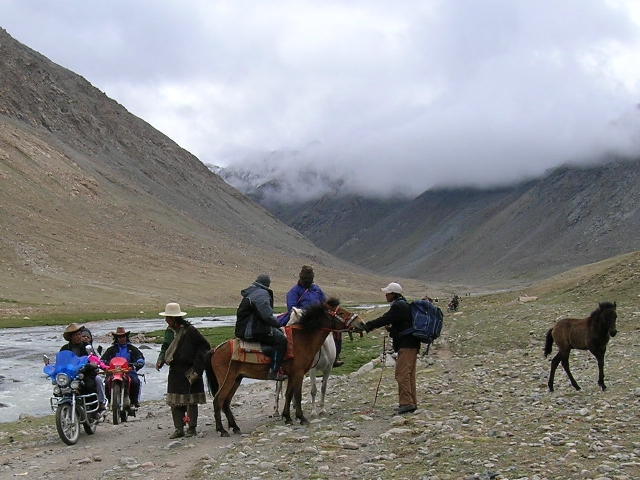 | Indian Party Evacuating with the Help of Locals |
To me, brought up in North-West England and now living in the U.S. Pacific Northwest, the conditions seem unremarkable and very familiar. Light wind, light rain, temperatures a few degrees above freezing - typical mountain walking weather. The Indians, however, are completely traumatized. They are leaving on horseback, on yaks, and riding pillion on motorcycles driven by the locals. They are shaking, hypothermic, and in shock, even though they are wearing multiple layers of clothing that leave not a single square inch of skin uncovered. I remember how when I lived in India, and the temperature would sometimes drop into the single digits Centigrade in the winter, there would be headlines in the paper and deaths from exposure.
Despite the urgency of the evacuation I am feeling pretty good about myself and my plan. It's only 9.15 a.m. and I am a third the way around the mountain. I even entertain fantasies of making it all the way around in one day. The Dirapuk monastery is less than a mile away across the river and I decide to swing by and visit it.
The first sign I am not in quite as good shape as I think is I am when I fail to find the bridge across the river, even though it couldn't be more obvious if it jumped up and bit me in the face. The second sign is when I take over an hour to travel half a mile on the wide, straight, level trail to the monastery. It is almost 11 a.m. when I arrive. The third sign is that I am unable to walk up the monastery steps even without my pack: I have to clamber up them on my hands and knees. No doubt about it - I have hit the wall, big time.
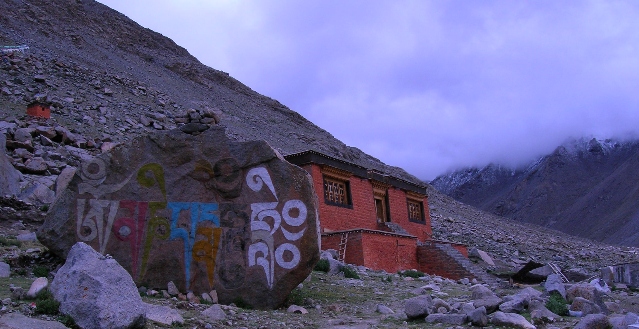 | Dirapuk Monastery |
I suddenly realize how completely unrealistic my plan is. I have committed myself to completing two circuits of the mountain by two days and exactly two hours from now, yet I have no control over my pace. If I hit the wall again, what happens? I can't expect my friends to wait for me, and this is a big mountain - there is no way for them to find me. And most important of all: why do I want to separate myself from them, anyway? I have been feeding my self-centeredness instead of starving it as a Buddhist on a pilgrimage is supposed to do.
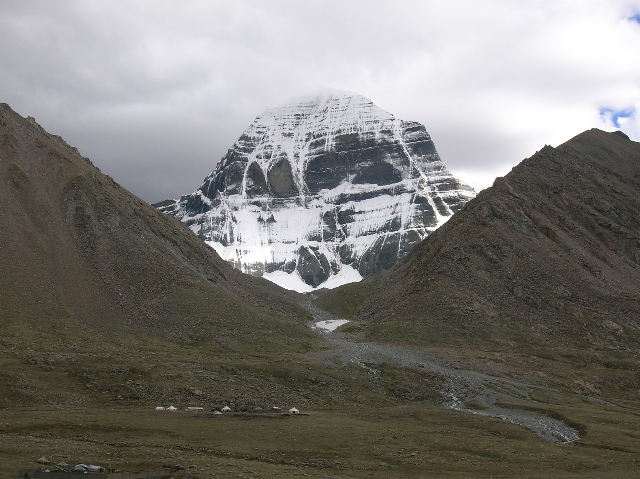 | View from Monastery Across the Valley |
The monastery has a big, pleasant dormitory: its windows have a magnificent view of the mountain. I check in and rest, waiting for my friends. I sleep for a couple of hours, then wake up when, even wearing all my clothes and under the monastery's thick blankets, I still can't get warm. I look across the valley and see a group of tents and some stone buildings - perhaps my group will decide to stay there? I can't spend my whole day shuffling from side to side of the valley, so I decide to stay where I feel most comfortable - which is here.
Our party shows up at the monastery around 5 - just as well, since I don't know it I would have had it in me to cross to the other side of the valley. They are very surprised to see me, but we all settle in, play a few games of Shithead, and head up to the monastery kitchen for hot water, tea, and tsampa (roasted barley flour), followed by an early night.
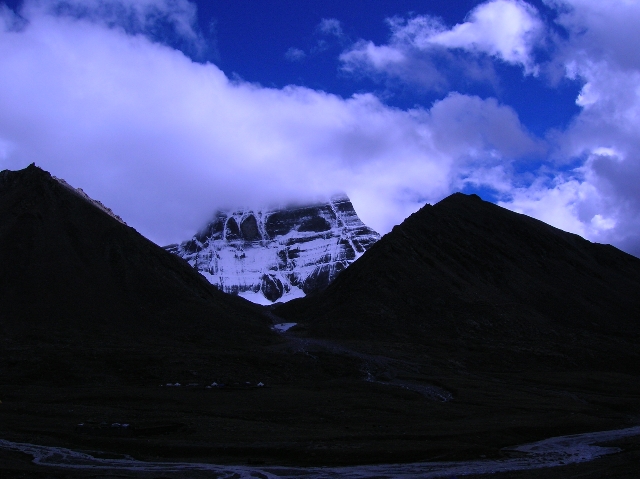 | Kailas Just Before Sunset |
Next Page
|







